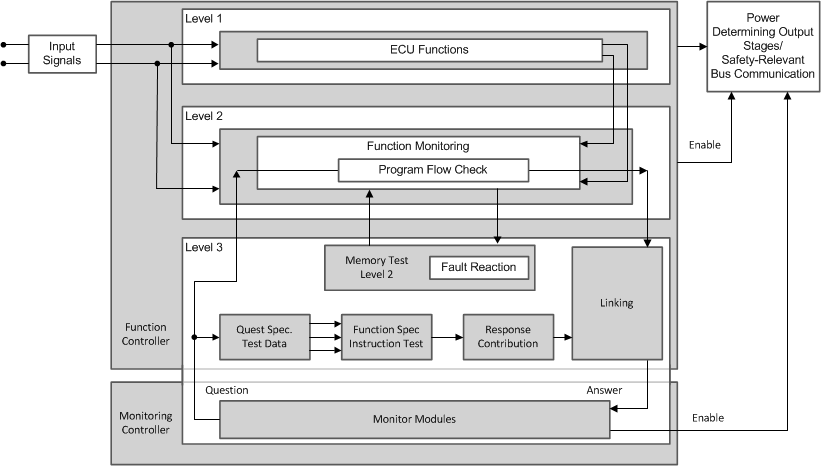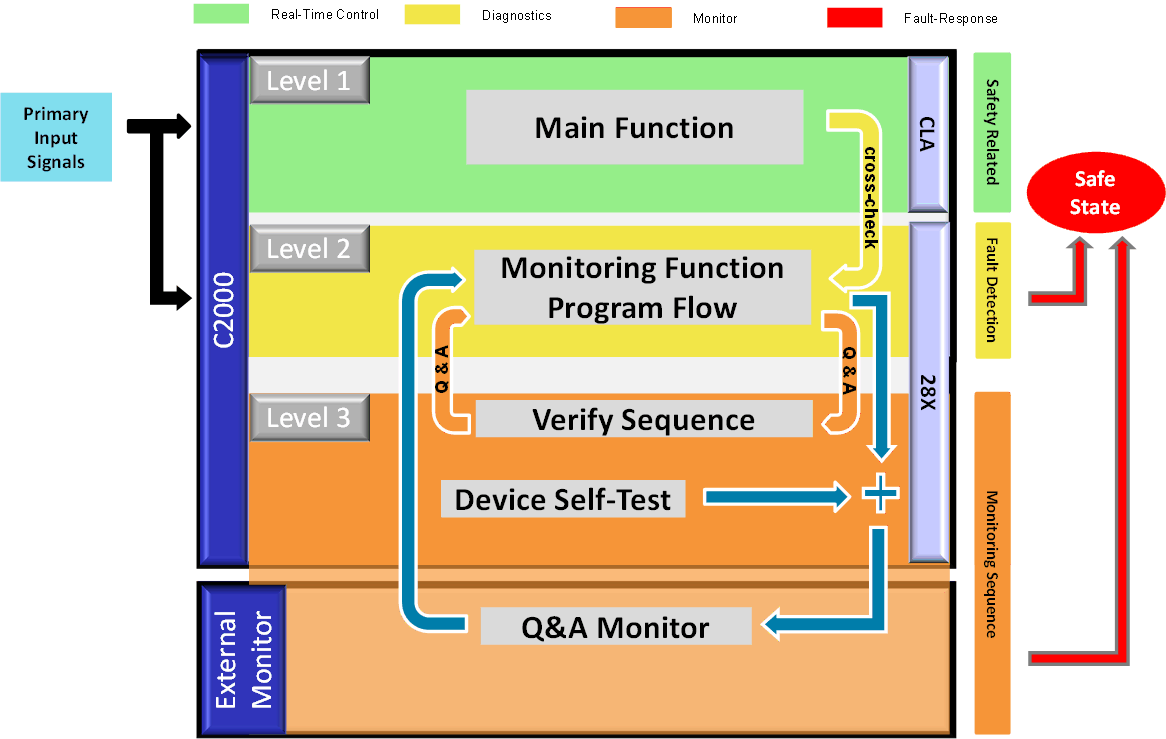SFFS700 May 2024 TMS320F28P650DH , TMS320F28P650DK , TMS320F28P650SH , TMS320F28P650SK , TMS320F28P659DH-Q1 , TMS320F28P659DK-Q1 , TMS320F28P659SH-Q1
- 1
- 1Introduction
- Trademarks
- 2Hardware Component Functional Safety Capability
- 3TI Development Process for Management of Systematic Faults
-
4TMS320F28P65x Component Overview
- 4.1 Targeted Applications
- 4.2
Hardware
Component Functional Safety Concept
- 4.2.1 VDA E-GAS Monitoring Concept
- 4.2.2 Fault Tolerant Time Interval (FTTI)
- 4.2.3 TMS320F28P65x MCU Safe State
- 4.2.4 Operating States
- 4.2.5 TMS320F28P65x MCU Safety Implementation
- 4.2.6 TMS320F28P65x Diagnostic Libraries
- 4.3 Functional Safety Constraints and Assumptions
-
5Description of Safety Elements
- 5.1 C2000 MCU Infrastructure Components
- 5.2 Processing Elements
- 5.3 Memory (Flash, SRAM and ROM)
- 5.4 On-Chip Communication Including Bus-Arbitration
- 5.5
Digital I/O
- 5.5.1 General-Purpose Input/Output (GPIO) and Pin Muxing
- 5.5.2 Enhanced Pulse Width Modulators (ePWM)
- 5.5.3 High Resolution PWM (HRPWM)
- 5.5.4 Enhanced Capture (eCAP)
- 5.5.5 High Resolution Capture (HRCAP)
- 5.5.6 Enhanced Quadrature Encoder Pulse (eQEP)
- 5.5.7 Sigma Delta Filter Module (SDFM)
- 5.5.8 External Interrupt (XINT)
- 5.6 Analog I/O
- 5.7
Data Transmission
- 5.7.1 Controller Area Network (DCAN)
- 5.7.2 Controller Area Network (MCAN, CAN FD)
- 5.7.3 Ethernet for Control Automation Technology (EtherCAT)
- 5.7.4 Serial Peripheral Interface (SPI)
- 5.7.5 Serial Communication Interface (SCI)
- 5.7.6 Universal Asynchronous Receiver/Transmitter (UART)
- 5.7.7 Local Interconnect Network (LIN)
- 5.7.8 Inter-Integrated Circuit (I2C)
- 5.7.9 Fast Serial Interface (FSI)
- 5.7.10 Power Management Bus Module (PMBus)
- 5.7.11 External Memory Interface (EMIF)
- 5.8 Not Safety Related Elements
-
6Management of Random Faults
- 6.1 Fault Reporting
- 6.2 Suggestions for Improving Freedom From Interference
- 6.3 Suggestions for Addressing Common Cause Failures
- 6.4
Descriptions of Functional Safety
Mechanisms
- 6.4.1
C2000 MCU Infrastructure Components
- 6.4.1.1 Clock Integrity Check Using DCC
- 6.4.1.2 Clock Integrity Check Using CPU Timer
- 6.4.1.3 Clock Integrity Check Using HRPWM
- 6.4.1.4 EALLOW and MEALLOW Protection for Critical Registers
- 6.4.1.5 External Clock Monitoring via XCLKOUT
- 6.4.1.6 External Monitoring of Warm Reset (XRSn)
- 6.4.1.7 External Voltage Supervisor
- 6.4.1.8 External Watchdog
- 6.4.1.9 Brownout Reset (BOR)
- 6.4.1.10 Glitch Filtering on Reset Pins
- 6.4.1.11 Hardware Disable of JTAG Port
- 6.4.1.12 Lockout of JTAG Access Using OTP
- 6.4.1.13 Internal Watchdog (WD)
- 6.4.1.14 Lock Mechanism for Control Registers
- 6.4.1.15 Missing Clock Detect (MCD)
- 6.4.1.16 NMIWD Reset Functionality
- 6.4.1.17 NMIWD Shadow Registers
- 6.4.1.18 Multibit Enable Keys for Control Registers
- 6.4.1.19 Online Monitoring of Temperature
- 6.4.1.20 Periodic Software Read Back of Static Configuration Registers
- 6.4.1.21 Peripheral Clock Gating (PCLKCR)
- 6.4.1.22 Peripheral Soft Reset (SOFTPRES)
- 6.4.1.23 Peripheral Access Protection – Type 1
- 6.4.1.24 Software Test of Reset – Type 1
- 6.4.1.25 PLL Lock Profiling Using On-Chip Timer
- 6.4.1.26 Reset Cause Information
- 6.4.1.27 Software Read Back of Written Configuration
- 6.4.1.28 Software Test of ERRORSTS Functionality
- 6.4.1.29 Software Test of Missing Clock Detect Functionality
- 6.4.1.30 Software Test of Watchdog (WD) Operation
- 6.4.1.31 Dual Clock Comparator (DCC) – Type 2
- 6.4.1.32 PLL Lock Indication
- 6.4.1.33 Software Test of DCC Functionality Including Error Tests
- 6.4.1.34 Software Test of PLL Functionality Including Error Tests
- 6.4.1.35 Interleaving of FSM States
- 6.4.1.36 Decryption of Encrypted Data Output Using Same KEY and IV
- 6.4.1.37 Software Test of Standalone GHASH Operation
- 6.4.2
Processing Elements
- 6.4.2.1 CPU Handling of Illegal Operation, Illegal Results and Instruction Trapping
- 6.4.2.2 Reciprocal Comparison by Software
- 6.4.2.3 Software Test of CPU
- 6.4.2.4 CPU Hardware Built-In Self-Test (HWBIST)
- 6.4.2.5 CPU Hardware Built-In Self-Test (HWBIST) Auto-Coverage
- 6.4.2.6 CPU Hardware Built-In Self-Test (HWBIST) Fault Injection Capability
- 6.4.2.7 CPU Hardware Built-In Self-Test (HWBIST) Timeout Feature
- 6.4.2.8 Software Test of CLA
- 6.4.2.9 CLA Handling of Illegal Operation and Illegal Results
- 6.4.2.10 CLA Liveness Check Using CPU
- 6.4.2.11 Disabling of Unused CLA Task Trigger Sources
- 6.4.2.12 Stack Overflow Detection
- 6.4.2.13 VCRC Check of Static Memory Contents
- 6.4.2.14 VCRC Auto Coverage
- 6.4.2.15 Hardware Redundancy Using Lockstep Compare Module (LCM)
- 6.4.2.16 Self-Test Logic for LCM
- 6.4.2.17 LCM Compare Error Forcing Mode
- 6.4.2.18 LCM MMR Parity
- 6.4.2.19 Test of LCM MMR Parity
- 6.4.2.20 Lockstep Self-test Mux Select Logic Fault Detection
- 6.4.2.21 Redundancy in LCM Comparator
- 6.4.2.22 Embedded Real Time Analysis and Diagnostic (ERAD)
- 6.4.2.23 Inbuilt Hardware Redundancy in ERAD Bus Comparator Module
- 6.4.3
Memory (Flash, SRAM and ROM)
- 6.4.3.1 Bit Multiplexing in Flash Memory Array
- 6.4.3.2 Bit Multiplexing in SRAM Memory Array
- 6.4.3.3 Data Scrubbing to Detect and Correct Memory Errors
- 6.4.3.4 Flash ECC
- 6.4.3.5 Flash Program Verify and Erase Verify Check
- 6.4.3.6 Flash Program and Erase Protection
- 6.4.3.7 Flash Wrapper Error and Status Reporting
- 6.4.3.8 Prevent 0 to 1 Transition Using Program Command
- 6.4.3.9 On-Demand Software Program Verify and Blank Check
- 6.4.3.10 CMDWEPROT* and Program Command Data Buffer Registers Self-Clear After Command Execution
- 6.4.3.11 ECC Generation and Checker Logic is Separate in Hardware
- 6.4.3.12 Auto ECC Generation Override
- 6.4.3.13 Software Test of ECC Logic
- 6.4.3.14 Software Test of Flash Prefetch, Data Cache and Wait-States
- 6.4.3.15 Access Protection Mechanism for Memories
- 6.4.3.16 SRAM ECC
- 6.4.3.17 SRAM Parity
- 6.4.3.18 Software Test of Parity Logic
- 6.4.3.19 Software Test of SRAM
- 6.4.3.20 Memory Power-On Self-Test (MPOST)
- 6.4.3.21 Background CRC
- 6.4.3.22 Watchdog for Background CRC
- 6.4.3.23 ROM Parity
- 6.4.3.24 Redundant Parity Engine
- 6.4.4
On-Chip Communication Including Bus-Arbitration
- 6.4.4.1 1oo2 Software Voting Using Secondary Free Running Counter
- 6.4.4.2 DMA Overflow Interrupt
- 6.4.4.3 Event Timestamping Using IPC Counter
- 6.4.4.4 Maintaining Interrupt Handler for Unused Interrupts
- 6.4.4.5 Majority Voting and Error Detection of Link Pointer
- 6.4.4.6 PIE Double SRAM Comparison Check
- 6.4.4.7 PIE Double SRAM Hardware Comparison
- 6.4.4.8 Power-Up Pre-Operational Security Checks
- 6.4.4.9 Software Check of X-BAR Flag
- 6.4.4.10 Software Test of ePIE Operation Including Error Tests
- 6.4.4.11 Disabling of Unused DMA Trigger Sources
- 6.4.4.12 Software Test of CLB Function Including Error Tests
- 6.4.4.13 Monitoring of CLB by eCAP or eQEP
- 6.4.4.14 Periodic Software Read Back of SPI Buffer
- 6.4.4.15 IPC 64-Bit Counter Value Plausibility Check
- 6.4.5
Digital I/O
- 6.4.5.1 ECAP Application Level Safety Mechanism
- 6.4.5.2 ePWM Application Level Safety Mechanism
- 6.4.5.3 ePWM Fault Detection Using XBAR
- 6.4.5.4 ePWM Synchronization Check
- 6.4.5.5 Online MINMAX Monitoring of TRIP Events
- 6.4.5.6 Fault Avoidance Using Minimum Dead Band
- 6.4.5.7 Fault Avoidance Using Illegal Combo Logic
- 6.4.5.8 Diode Emulation Mode Monitoring
- 6.4.5.9 eQEP Application Level Safety Mechanisms
- 6.4.5.10 eQEP Quadrature Watchdog
- 6.4.5.11 eQEP Software Test of Quadrature Watchdog Functionality
- 6.4.5.12 Hardware Redundancy
- 6.4.5.13 HRPWM Built-In Self-Check and Diagnostic Capabilities
- 6.4.5.14 Information Redundancy Techniques
- 6.4.5.15 Monitoring of ePWM by eCAP
- 6.4.5.16 Monitoring of ePWM by ADC
- 6.4.5.17 Online Monitoring of Interrupts and Events
- 6.4.5.18 SDFM Comparator Filter for Online Monitoring
- 6.4.5.19 SD Modulator Clock Fail Detection Mechanism
- 6.4.5.20 Software Test of Function Including Error Tests
- 6.4.5.21 Monitoring of HRPWM by HRCAP
- 6.4.5.22 HRCAP Calibration Logic Test Feature
- 6.4.5.23 QMA Error Detection Logic
- 6.4.6
Analog I/O
- 6.4.6.1 ADC Information Redundancy Techniques
- 6.4.6.2 ADC Input Signal Integrity Check
- 6.4.6.3 ADC Signal Quality Check by Varying Acquisition Window
- 6.4.6.4 Hardware Redundancy with ADC Safety Checker
- 6.4.6.5 Hardware Redundancy of ADC Safety Checker
- 6.4.6.6 Disabling Unused Sources of SOC Inputs to ADC
- 6.4.6.7 CMPSS Ramp Generator Functionality Check
- 6.4.6.8 DAC to ADC Loopback Check
- 6.4.6.9 DAC to Comparator Loopback Check
- 6.4.6.10 Opens/Shorts Detection Circuit for ADC
- 6.4.6.11 VDAC Conversion by ADC
- 6.4.7
Data Transmission
- 6.4.7.1 Bit Error Detection
- 6.4.7.2 CRC in Message
- 6.4.7.3 DCAN Acknowledge Error Detection
- 6.4.7.4 DCAN Form Error Detection
- 6.4.7.5 DCAN Stuff Error Detection
- 6.4.7.6 PWM Trip by MCAN
- 6.4.7.7 MCAN Stuff Error Detection
- 6.4.7.8 MCAN Form Error Detection
- 6.4.7.9 MCAN Acknowledge Error Detection
- 6.4.7.10 Timeout on FIFO Activity
- 6.4.7.11 Timestamp Consistency Checks
- 6.4.7.12 Tx-Event Checks
- 6.4.7.13 Interrupt on Message RAM Access Failure
- 6.4.7.14 Software Test of Function Including Error Tests Using EPG
- 6.4.7.15 EMIF Access Latency Profiling Using On-Chip Timer
- 6.4.7.16 EMIF Access Protection Mechanism
- 6.4.7.17 EMIF Asynchronous Memory Timeout Protection Mechanism
- 6.4.7.18 I2C Access Latency Profiling Using On-Chip Timer
- 6.4.7.19 Information Redundancy Techniques Including End-to-End Safing
- 6.4.7.20 I2C Data Acknowledge Check
- 6.4.7.21 Parity in Message
- 6.4.7.22 Break Error Detection
- 6.4.7.23 Frame Error Detection
- 6.4.7.24 Overrun Error Detection
- 6.4.7.25 Software Test of Function Using I/O Loopback
- 6.4.7.26 SPI Data Overrun Detection
- 6.4.7.27 Transmission Redundancy
- 6.4.7.28 Data Parity Error Detection
- 6.4.7.29 LIN Physical Bus Error Detection
- 6.4.7.30 LIN No-Response Error Detection
- 6.4.7.31 LIN Checksum Error Detection
- 6.4.7.32 LIN ID Parity Error Detection
- 6.4.7.33 Communication Access Latency Profiling Using On-Chip Timer
- 6.4.7.34 FSI Data Overrun and Underrun Detection
- 6.4.7.35 FSI Frame Overrun Detection
- 6.4.7.36 FSI CRC Framing Checks
- 6.4.7.37 FSI ECC Framing Checks
- 6.4.7.38 FSI Frame Watchdog
- 6.4.7.39 FSI RX Ping Watchdog
- 6.4.7.40 FSI Tag Monitor
- 6.4.7.41 FSI Frame Type Error Detection
- 6.4.7.42 FSI End of Frame Error Detection
- 6.4.7.43 FSI Register Protection Mechanisms
- 6.4.7.44 PMBus Protocol CRC in Message
- 6.4.7.45 PMBus Clock Timeout
- 6.4.7.46 EtherCAT MDIO Command Error Indication
- 6.4.7.47 EtherCAT Sync-Manager
- 6.4.7.48 EtherCAT Working Counter Error Indication
- 6.4.7.49 EtherCAT Frame Error Indication
- 6.4.7.50 EtherCAT Physical Layer Error Indication
- 6.4.7.51 PDI Timeout Error Indication
- 6.4.7.52 EtherCAT EEPROM CRC Error Indication
- 6.4.7.53 EtherCAT EEPROM Not Done Error Indication
- 6.4.7.54 EtherCAT Data Link Error Indication
- 6.4.7.55 EtherCAT Phy Link Error Indication
- 6.4.7.56 Sync, GPO Monitoring Using External Monitor
- 6.4.7.57 EtherCAT Enhanced Link Detection With LED
- 6.4.7.58 HW Redundancy of GPIO, FMMU, Sync Manager and SYNC OUT
- 6.4.1
C2000 MCU Infrastructure Components
- 7References
- A Summary of Safety Features and Diagnostics
- B Distributed Developments
4.2.1 VDA E-GAS Monitoring Concept
The standardized E-GAS monitoring concept (6) for engine management systems generated by the German VDA working group “E-Gas-Arbeitskreis” is an example of a well-trusted safety-architecture that may be used for applications other than engine management systems provided it fits the purpose of the new application in terms of diagnosis feasibility, environment constraints, time constraints, robustness, and so forth (7). For more information, see Figure 4-4.
 Figure 4-4 E-GAS
System Overview From Standard
Figure 4-4 E-GAS
System Overview From StandardThe TMS320F28P65xD/S MCU device family supports heterogeneous asymmetric architecture and their functional safety features lend themselves to an E-GAS concept implementation at system level as indicated in Figure 4-5. In the first level (Level 1), the functions required for the system mission are computed. Second level (Level 2) checks the correct formation in first level based on selected set of parameters. Third level (Level 3) implements an additional external monitoring element, for the correct carrying out of the mission in the first level and/or monitoring in the second level. The exact functional safety implementation and the modules used for realizing Level 1 and Level 2 and the external monitoring device for realizing Level 3 are left to the system designer. Though Figure 4-5 indicates CLA implementing Level 1 and CPU(28x) implementing Level 2 of the EGAS monitoring concept, both the processing units are capable of implementing either of the levels. The application can determine the partitioning based on the system requirements.
 Figure 4-5 VDA E-Gas Monitoring Concept
Applied to C2000 MCU
Figure 4-5 VDA E-Gas Monitoring Concept
Applied to C2000 MCU